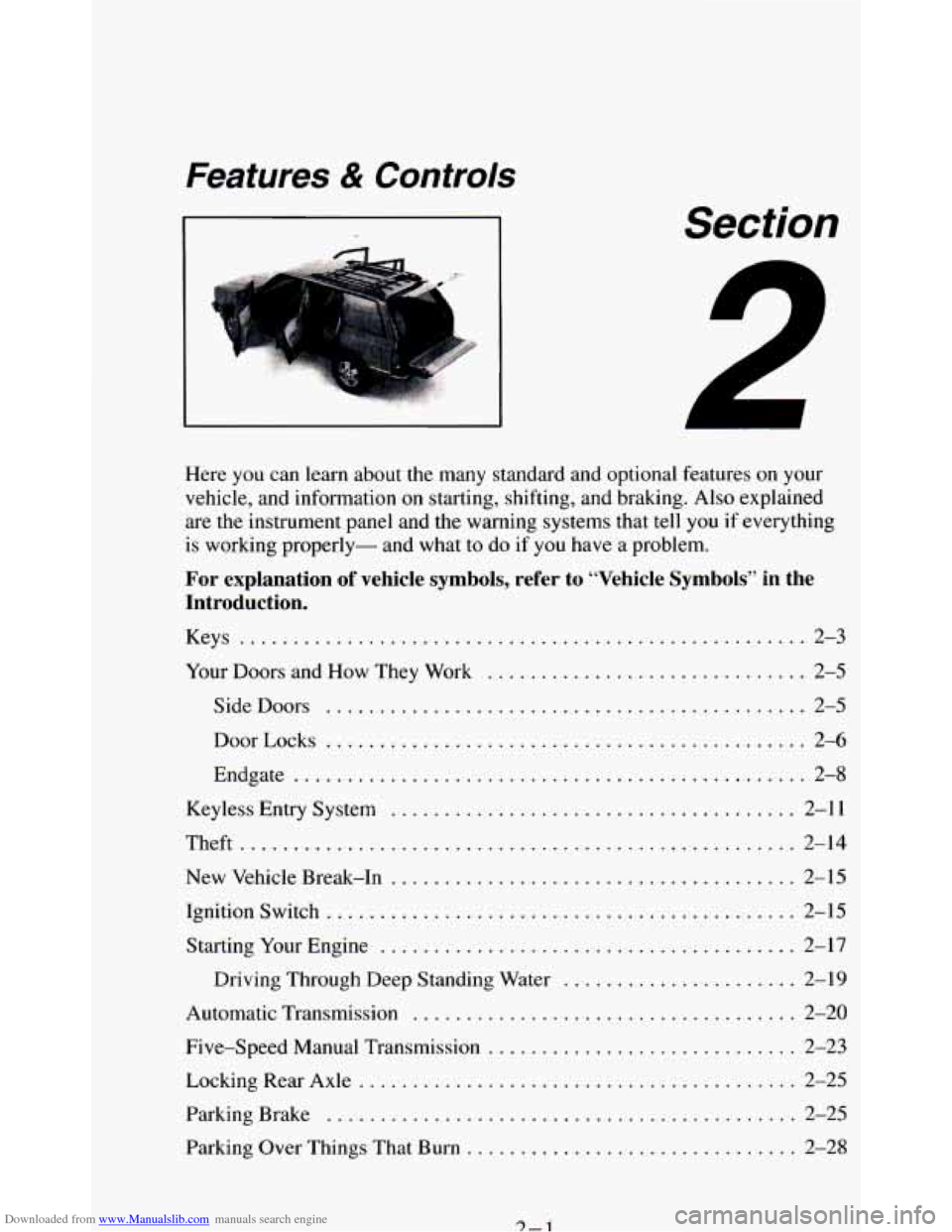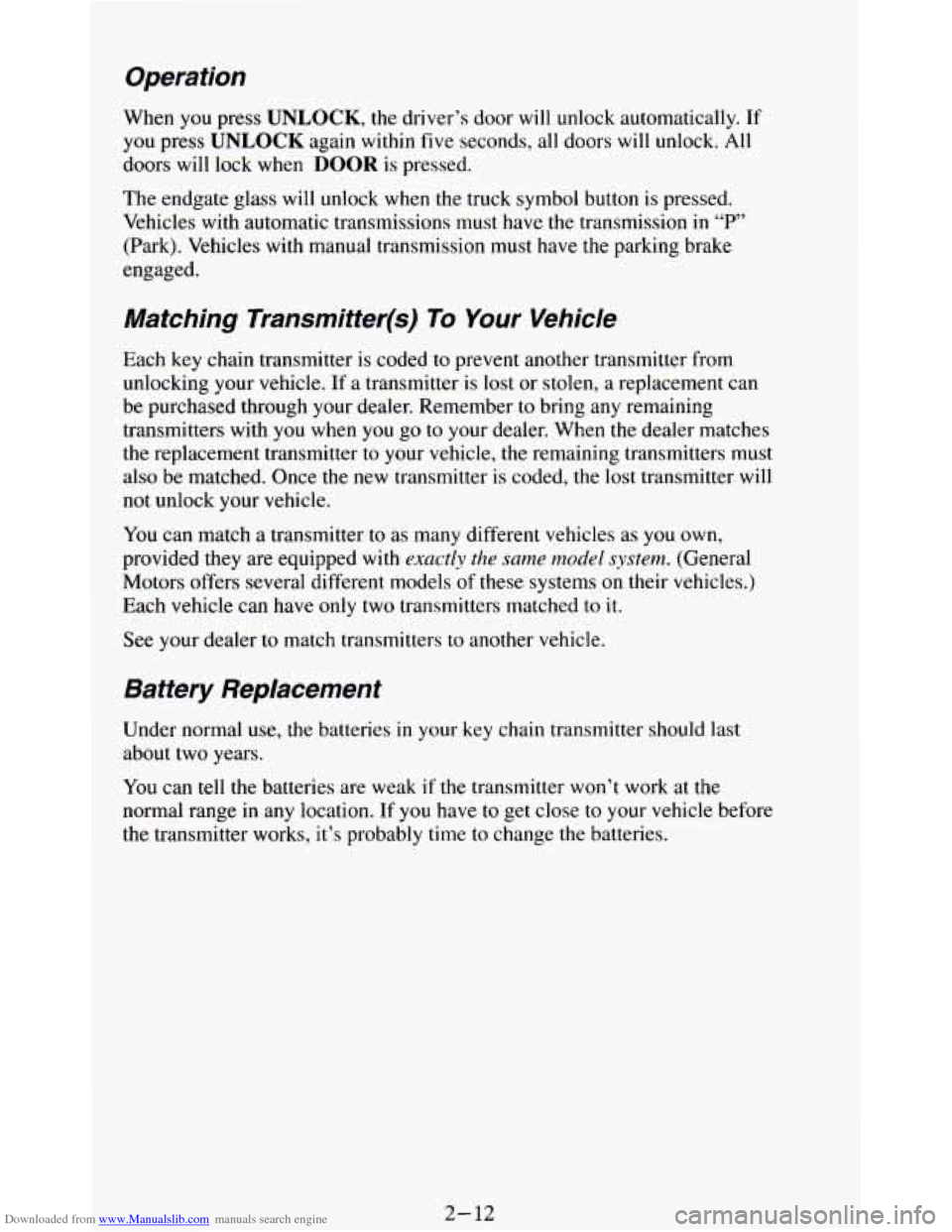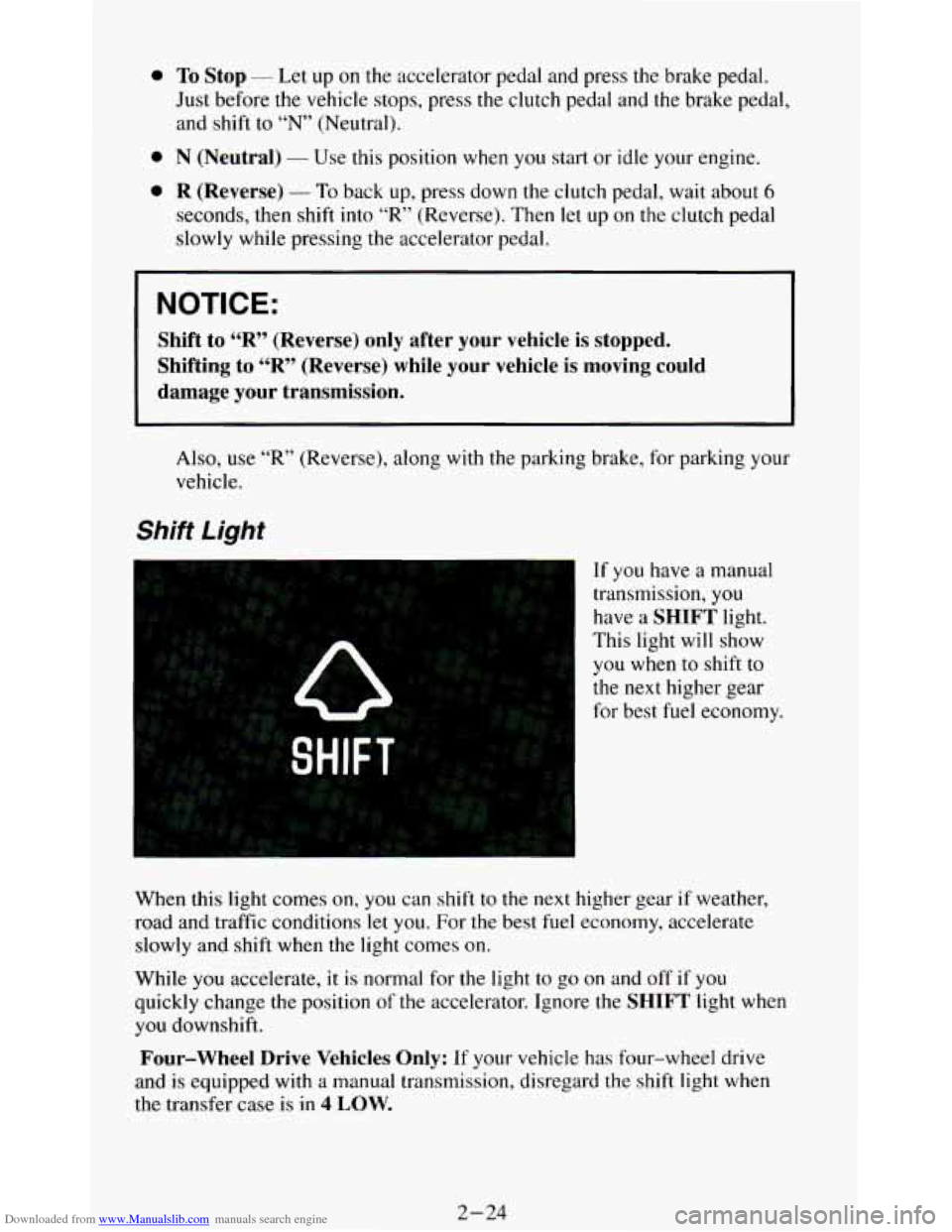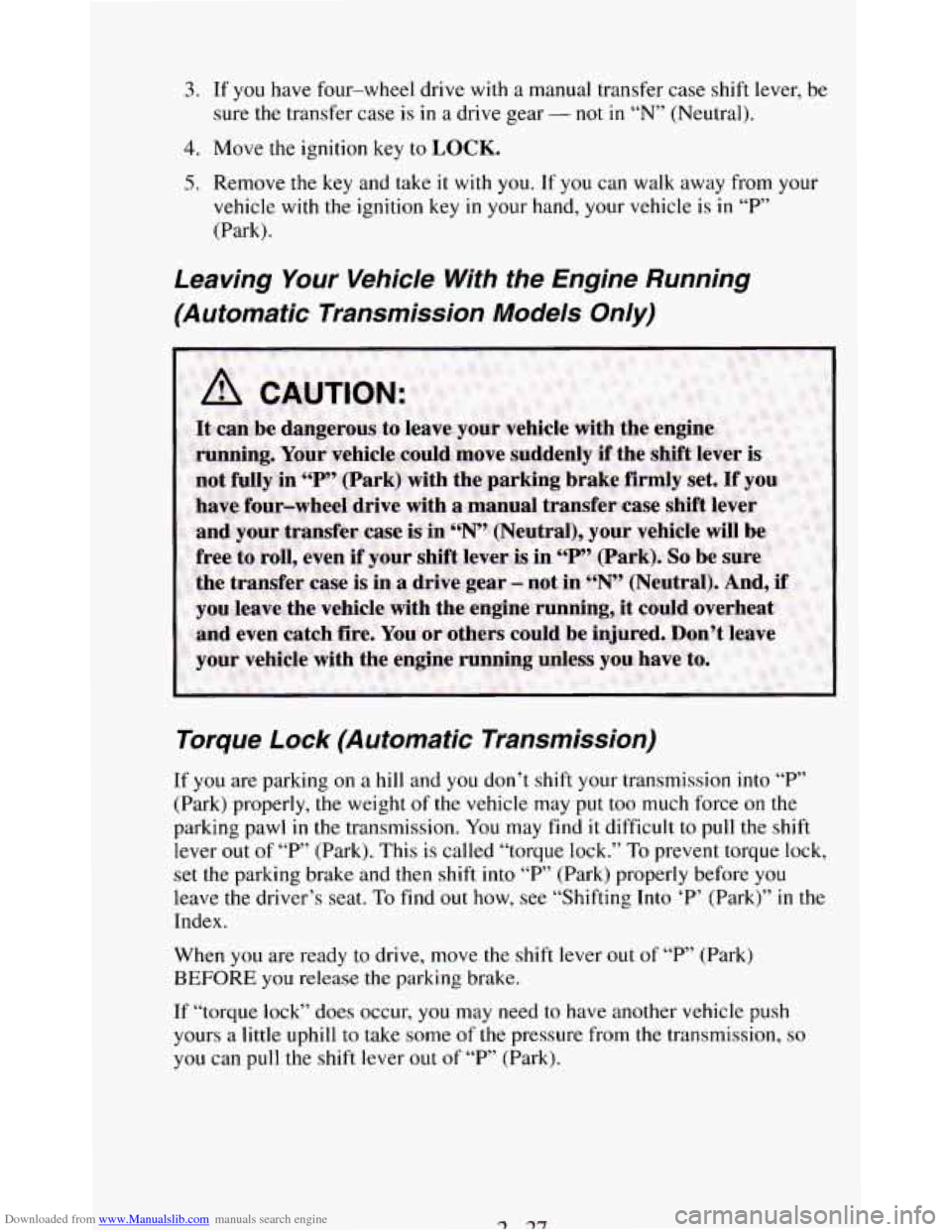Page 55 of 348

Downloaded from www.Manualslib.com manuals search engine Features & Controls
Section
Here you can learn about the many standard and optional features on your
vehicle, and information on starting, shifting, and braking. Also explained
are the instrument panel and the warning systems
that tell you if everything
is working properly- and what to do if you have a problem.
For explanation of vehicle symbols, refer to "Vehicle Symbols" in the
Introduction.
Keys ..................................................... 2-3
Your Doors and
How They Work . . . . . . . . . . . . . . . . . . . . . . . . . . . . . . 2-5
SideDoors
............................................. 2-5
DoorLocks ...................... ..................... 2-6
Endgate
................................................ 2-8
Keyless
Entry System . . . . . . . . . . . . . . . . . . . . . . . . . . . . . . . . . . . . . . 2-1 1
Theft .................................................... 2-14
New Vehicle Break-In . . . . . . . . . . . . . . . . . . . . . . . . . . . . . . . . . . . . . . 2-15
Ignitionswitch
............................................ 2-15
Starting Your Engine . . . . . . . . . . . . . . . . . . . . . . . . . . . . . . . . . . . . . . . 2-17
Driving Through Deep Standing Water
. . . . . . . . . . . . . . . . . . . . . . 2-19
Automatic Transmission
. . . . . . . . . . . . . . . . . . . . . . . . . . . . . . . . . . . . 2-20
Five-Speed Manual Transmission
. . . . . . . . . . . . . . , , . . . . . . . . . . . . . 2-23
Locking Rear Axle
. . . . . . . . . . . . . . . . . . . . . . . . . . . . . . . . . . . , . . . . . 2-25
ParkingBrake
............................................ 2-25
Parking Over Things That Burn . . . . . . . . . . . . . . . . . . . . . . . . . . . . . . . 2-28
3-1
Page 63 of 348
Downloaded from www.Manualslib.com manuals search engine Electric Endgafe Glass Release
The electric endgate
glass release lets you
open your endgate
glass by just pressing
a button. The button is
to the left
of your
radio.
If your vehicle has an automatic transmission, your shift lever must be in
“P” (Park) or “N” (Neutral) for the release to work.
If you have a manual transmission, either
with or without the Keyless Entry
option, you must apply your parking brake before you can open the endgate
glass.
2-9
Page 66 of 348

Downloaded from www.Manualslib.com manuals search engine Operation
When you press UNLOCK, the driver’s door will unlock automatically. If
you press UNLOCK again within five seconds, all doors will unlock. All
doors will lock when
DOOR is pressed.
The endgate glass will unlock when the truck symbol button
is pressed.
Vehicles with automatic transmissions must have the transmission
in “P”
(Park). Vehicles with manual transmission must have the parking brake
engaged.
Matching Transmitter(s) To Your Vehicle
Each key chain transmitter is coded to prevent another transmitter from
unlocking your vehicle.
If a transmitter is lost or stolen, a replacement can
be purchased through your dealer. Remember
to bring any remaining
transmitters with you when
you go to your dealer. When the dealer matches
the replacement transmitter to your vehicle, the remaining transmitters must
also be matched. Once the new transmitter is coded, the
lost transmitter will
not unlock your vehicle.
You can match a transmitter to as many different vehicles as you own,
provided they are equipped
with exactly the same model system. (General
Motors offers several different models
of these systems on their vehicles.)
Each vehicle can have only two transmitters matched to it.
See your dealer
to match transmitters to another vehicle.
Battery Replacement
Under normal use, the batteries in your key chain transmitter should last
about two years.
You can tell the batteries are weak
if the transmitter won’t work at the
normal range in any location. If
you have to get close to your vehicle before
the transmitter works, it’s probably time
to change the batteries.
2- 12
Page 78 of 348

Downloaded from www.Manualslib.com manuals search engine a
0
a
To Stop - Let up on the accelerator pedal and press the brake pedal.
Just before the vehicle stops, press
the clutch pedal and the brake pedal,
and shift to
“N” (Neutral).
N (Neutral) - Use this position when you start or idle your engine.
R (Reverse) - To back up, press down the clutch pedal, wait about 6
seconds, then shift into “R” (Reverse). Then let up on the clutch pedal
slowly while pressing the accelerator pedal.
NOTICE:
Shift to “R” (Reverse) only after your vehicle is stopped.
Shifting to
“R” (Reverse) while your vehicle is moving could
damage your transmission.
Also, use “R’ (Reverse), along with the parking brake, for parking your
vehicle.
Shift Light
If you have a manual
transmission,
you
have a SHIFT light.
This light will show
you when to shift to
the next higher gear
for best fuel economy.
When this light comes
on, you can shift to the next higher gear if weather,
road and traffic conditions
let you. For the best fuel economy, accelerate
slowly and shift when the light comes on.
While
you accelerate, it is normal for the light to go on and off if you
quickly change the position
of the accelerator. Ignore the SHIFT light when
you downshift.
Four-wheel Drive Vehicles Only: If your vehicle has four-wheel drive
and
is equipped with a manual transmission, disregard the shift light when
the transfer case is in
4 LOW.
2-24
Page 79 of 348
Downloaded from www.Manualslib.com manuals search engine Locking Rear Axle
If you have this feature, your rear axle can give you additional traction on
snow, mud, ice, sand or gravel. It works like a standard axle most of the
time, but when one of the rear wheels has no traction and the other does, the
locking feature will allow the wheel with traction
to move the vehicle.
Parking Brake
-
To Set the Parking Brake:
To Release the Parking Brake:
Hold the regular brake
pedal down
with your
right foot. Push down
the parking brake
pedal with your left
foot. If the ignition is
on, the brake system
warning light will
come
on.
Hold the regular brake
pedal down. Pull the
brake release lever.
I NOTICE: I
Driving with the parking brake on can cause your rear brakes to
overheat.
You may have to replace them, and you could also
damage other parts
of your vehicle.
3 -3.5
Page 80 of 348
Downloaded from www.Manualslib.com manuals search engine If you are on a hill: See “Parking on Hills” in the Index. That section
shows how to turn your front wheels.
If you are towing a trailer and are parking on any hill: See “Towing a
Trailer” in the Index. That section
shows what to do first to keep the trailer
from moving.
Shifting /nto “P” (Park) (Automatic
Transmission
Models On/y)
1. Hold the brake pedal down with your right foot and set the parking
brake.
2. Move the shift
lever into
“P”
(Park) position
like this:
Pull the lever toward you.
Move the lever up as far as it will go.
2-26
Page 81 of 348

Downloaded from www.Manualslib.com manuals search engine 3. If you have four-wheel drive with a manual transfer case shift lever, be
sure
the transfer case is in a drive gear - not in “N” (Neutral).
4. Move the ignition key to LOCK.
5. Remove the key and take it with you. If you can walk away from your
vehicle with the ignition
key in your hand, your vehicle is in “P”
(Park).
Leaving Your Vehicle With the Engine Running
(Automatic Transmission Models Only)
Torque Lock (Automatic Transmission)
If you are parking on a hill and you don’t shift your transmission into “P”
(Park) properly,
the weight of the vehicle may put too much force on the
parking pawl
in the transmission. You may find it difficult to pull the shift
lever
out of “P’ (Park). This is called “torque lock.” To prevent torque lock,
set the parking brake and then
shift into “P” (Park) properly before you
leave the driver’s seat. To find out how, see “Shifting Into ‘P’ (Park)” in the
Index.
When
you are ready to drive, move the shift lever out of “P” (Park)
BEFORE you release the parking brake.
If “torque
lock” does occur, you may need to have another vehicle push
yours a
little uphill to take some of the pressure from the transmission, so
you can pull the shift lever out of ‘Y’ (Park).
3 31
Page 82 of 348
Downloaded from www.Manualslib.com manuals search engine Parking Your Vehicle (Manual Transmission
Models Only)
Before you get out of your vehicle, turn off your engine, put your manual
transmission
in “R” (Reverse) and firmly apply the parking brake.
If you have four-wheel drive with a manual transfer case shift lever, be sure
your transfer case is in
a drive gear. Your vehicle could roll if it isn’t.
If you are parking on a hill, or if your vehicle is equipped to tow a trailer,
see “Parking on Hills” or “Towing a Trailer”
in the Index.
Parking Over Things That Burn
2-28